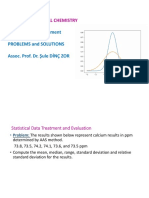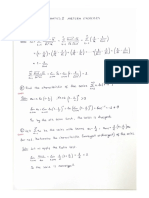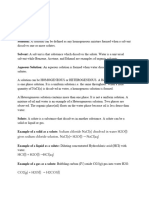CHE211 Problem Set 1
CHE211 Problem Set 1
Uploaded by
AlexCopyright:
Available Formats
CHE211 Problem Set 1
CHE211 Problem Set 1
Uploaded by
AlexOriginal Description:
Copyright
Available Formats
Share this document
Did you find this document useful?
Is this content inappropriate?
Copyright:
Available Formats
CHE211 Problem Set 1
CHE211 Problem Set 1
Uploaded by
AlexCopyright:
Available Formats
CHE 211 BASIC PRINCIPLES IN CHEMICAL ENGINEERING
2021- 2022 Fall Semester
Doç.Dr. Funda TURGUT BAŞOĞLU
Problem Set I
1. Felder , 3 rd ed., 4.6
2. Felder , 3 rd ed., 4.7
3. Felder , 3 rd ed., 4.10
4. Felder , 3 rd ed. 4.12
5. A manufacturer of briquets has a contract to make briquets for barbecuing that are guaranteed to
not contain over 10% moisture or 10% ash. The basic material they use has the analysis: moisture
12.4%, volatile material 16.6%,carbon 57.5%, and ash 13.5%. To meet the specifications ( at their
limits ) they plan to mix with the base material a certain amount of petroleum coke that has the
analysis: volatile material 8.2%, carbon 88.7%, and moisture 3.1%. How much petroleum coke
must be added per 100 lb of the base material?
6. If 100 g of Na 2 SO 4 is dissolved in 200 g of H 2 O and the solution is cooled until 100 g of
Na 2 SO 4 ·10H 2 O crystallizes out, find
a. The composition of the remaining solution ( mother liquor ).
b. The grams of crystals recovered per 100 g of initial solution.
7. The crude oil is fed to a washing unit and in this unit it is mixed with fresh water fed to the
washing unit. Crude oil contains salt and oil. There are two exit streams from washing unit. The
first stream is the oil stream. The oil stream contains 5% salt but not water. The second stream is
“spent wash water” stream. This stream contains 15% salt and the balance water. The mass ratio
of crude oil to fresh water used is 4:1. All compositions are given on mass basis.
a) Draw and label a flowchart to this process
b) Do the degree of freedom analysis. Prove that for an assumed basis of calculation, flow rate
and compositions of all process streams can be calculated from the given information.
c) Calculate flow rate and compositions of all process streams for 100 kg of oil stream taken as
product.
8. Ammonia is a gas for which reliable analytical methods are available to determine its concentration
in other gases. To measure flow in a natural gas pipeline, pure ammonia gas is injected into the
pipeline at a constant rate of 72.3 kg/min for 12 min. Five miles downstream from the injection
point, the steady-state ammonia concentration is found to be 0.382 weight percent. The gas
upstream from the point of ammonia injection contains no measurable ammonia. How many
kilograms of natural gas are flowing through the pipelines per hour?
9. Sludge is wet solids that result from the processing in municipal sewage systems. The sludge has to
be dried before it can be composted or otherwise handled. If a sludge containing 70% water and
30% solids is passed through drier and the resulting product contains 25% water, how much water
is evaporated per ton of sludge sent to the drier?
10. A stream of 5 wt % oleic acid (A) in cottonseed oil (O) enters an extraction unit at a rate of 100
kg/hr. A seperate stream of propane (P) also enters the same unit. Propane is able to dissolve
oleic acid but can not mix with the cottonseed oil. Two streams exit the unit: One stream
contains propane and 90% of the oleic acid that enters the process. The concentration of
oleic acid in this stream is 6.15 wt%. The second stream contains all of the cotton seed oil
along with the remaining oleic acid.
(a) Draw and label the flow chart.. Perform a degree of freedom analysis.
(b) Determine the unknown flow rates.
11.A tank holds 1000 kg of a saturated solution of Na 2 CO 3 at 30 °C. You want to crystallize from
this solution 531 kg of Na 2 CO 3 . 10 H 2 O without any accompanying water. To what temperature
must the solution be cooled? Molecular weights : Na 2 CO 3 :106, H 2 O: 18 The solubility data are
given in the following table.
Temperature(° C ) 0 10 20 30
Solubility,g Na 2 CO 3 /100gH 2 O 7 12.5 21.5 38.8
12. A gas mixture containing CH 4 , C 2 H 6 and N 2 has to be prepared with the use of following three gas
streams. (1) N 2 -CH 4 mixture ( 80 % N 2 and 20 % CH 4 ), (2) A gas mixture of 90 % N 2 and 10
% C 2 H 6 and (3) Pure nitrogen. Mole ratio of CH 4 to C 2 H 6 will be 1.5:1.0 in the final prepared
mixture.
a) Draw a flowchart and label the unknown variables.
b) Do degrees of freedom analysis. For the calculation of flow rates and compositions of all
process streams how many additional data are required ?
13. 100 kg/h of a solution of soda ash (Na 2 CO 3 ) in water, ( 30% Na 2 CO 3 ) is cooled slowly to 20 0C.
The crystals formed are decahydrate, Na 2 CO 3 .10 H 2 O. The solubility of the Na 2 CO 3
at 20 0C is 21.5 kg of Na 2 CO 3 per 100 kg of water. During cooling %3 of water in the soda
ash solution is lost by evaporation. Na 2 CO 3 :106 , Na 2 CO 3 .10 H 2 O: 286
(a) Draw the flow chart of the process , do the degrees of freedom analysis.
(b) Calculate the weight of the cystals formed .
You might also like
- Sinav 2-CevaplarDocument2 pagesSinav 2-CevaplarAlexNo ratings yet
- Assignment ReactiveDocument2 pagesAssignment ReactiveNUREEN DAYANA BINTI MOHD IZMANIZAN A21ET01940% (1)
- Assig 2 Che422 Spring 2012Document3 pagesAssig 2 Che422 Spring 2012ⵃⴰⵎⵣⴰ ⵖⵉⵢⵜNo ratings yet
- Che219 Case1 Gaseous and LiquidDocument9 pagesChe219 Case1 Gaseous and LiquidMargaret FloresNo ratings yet
- Sample Questions For Chemical EngineeringDocument36 pagesSample Questions For Chemical EngineeringChristopere DepasupilNo ratings yet
- Assignment CPP Jan 2020 PDFDocument5 pagesAssignment CPP Jan 2020 PDFNur Afifah IINo ratings yet
- B48BA Tutorial 3 - Mass Balance W ReactionsDocument2 pagesB48BA Tutorial 3 - Mass Balance W ReactionsMohamed AbdullaNo ratings yet
- 01 - Ideal Gas Worksheets KEYDocument6 pages01 - Ideal Gas Worksheets KEYMarina XuNo ratings yet
- Belvar RSKB-104 Geiger Counter Instruction ManualDocument31 pagesBelvar RSKB-104 Geiger Counter Instruction ManualgeoffffNo ratings yet
- Untitled DocumentDocument3 pagesUntitled DocumentRoxan MoraNo ratings yet
- Lectut CHN-102 PDF ReactiveDocument4 pagesLectut CHN-102 PDF ReactiveTanmaysainiNo ratings yet
- Checal Module 4 - Example ProblemsDocument14 pagesChecal Module 4 - Example ProblemsAngelica NuñezNo ratings yet
- Sample Problem Mod 3 CPCDocument6 pagesSample Problem Mod 3 CPCAman PratikNo ratings yet
- Cpe 420 Tutorial 2Document3 pagesCpe 420 Tutorial 2Muhamad Baihakhi ShamsudinNo ratings yet
- Checal 2 Module ProblemsDocument3 pagesChecal 2 Module Problems5zywgtdkw5No ratings yet
- CPC QB Full 2013Document7 pagesCPC QB Full 2013Arul KamalakumarNo ratings yet
- r050210803 Chemical Process CalculationsDocument8 pagesr050210803 Chemical Process CalculationsSrinivasa Rao GNo ratings yet
- Mass Balance Tutorial 2 - 2021 Fin-StuDocument2 pagesMass Balance Tutorial 2 - 2021 Fin-StuToanique HeadmanNo ratings yet
- CHE 202 Tutorial QuestionDocument6 pagesCHE 202 Tutorial QuestionFawziyyah AgboolaNo ratings yet
- Checal ReviewerDocument8 pagesChecal ReviewerChristian Dela CruzNo ratings yet
- 40568Document14 pages40568Jelain HumarangNo ratings yet
- Combustion ProblemsDocument2 pagesCombustion ProblemsMary Grace Garcia100% (2)
- Design (Ch.1 Problems)Document5 pagesDesign (Ch.1 Problems)John UnkNo ratings yet
- Gaseous FuelsDocument5 pagesGaseous FuelsShane PatulotNo ratings yet
- Additional Problems On Material Balances PDFDocument4 pagesAdditional Problems On Material Balances PDFEliot Kh0% (1)
- Assignment 2 DR Azizul PDFDocument4 pagesAssignment 2 DR Azizul PDFjinNo ratings yet
- Chemical Engineering Calculations - Midterm ExamDocument12 pagesChemical Engineering Calculations - Midterm ExamJohnNo ratings yet
- Problemario B.E. Segundo ParcialDocument4 pagesProblemario B.E. Segundo ParcialjorgeNo ratings yet
- Sample Paper 2Document3 pagesSample Paper 2Timothy JonesNo ratings yet
- TK-315 CPI2 - 1 - NonReacting SystemsDocument33 pagesTK-315 CPI2 - 1 - NonReacting SystemsBayu Purnama Ridjadi75% (4)
- Problems in Material BalanceDocument28 pagesProblems in Material BalanceKent GardoseNo ratings yet
- CHE211 Problem Set 5Document3 pagesCHE211 Problem Set 5AlexNo ratings yet
- Homework #2 For Chemical Process Calculation PDFDocument2 pagesHomework #2 For Chemical Process Calculation PDFUrgen TamangNo ratings yet
- Chemical Process CalculationsDocument8 pagesChemical Process Calculationsbhaskar5377No ratings yet
- SKKK1113 Tutorial Assignment-04-ReactiveDocument2 pagesSKKK1113 Tutorial Assignment-04-ReactiveNUREEN DAYANA BINTI MOHD IZMANIZAN A21ET0194No ratings yet
- CHEE2001 Week 2 Tutorial SheetDocument2 pagesCHEE2001 Week 2 Tutorial SheetMuntaha ManzoorNo ratings yet
- Tutorial IIDocument5 pagesTutorial IIMushtansir AnsariNo ratings yet
- CHE 251 Assignment 3Document2 pagesCHE 251 Assignment 3Appah Ernest OpokuNo ratings yet
- Orca Share Media1567598084691Document10 pagesOrca Share Media1567598084691Kobe AcobNo ratings yet
- CHE Calculations (Additional Problems)Document11 pagesCHE Calculations (Additional Problems)Karla IsraelNo ratings yet
- Mass Fraction and Mol Fraction PDFDocument2 pagesMass Fraction and Mol Fraction PDFZezy BlueNo ratings yet
- (358004360) 1. Mass Fraction and Mol FractionDocument2 pages(358004360) 1. Mass Fraction and Mol FractionZezy Blue100% (1)
- Week 7 TutorialDocument4 pagesWeek 7 TutorialHua KhienNo ratings yet
- Material Balance SheetDocument4 pagesMaterial Balance Sheetsyed waheed ul hasanNo ratings yet
- CHE Calculations Questions 18-Mar-2023Document6 pagesCHE Calculations Questions 18-Mar-2023zedrickNo ratings yet
- BdeM Taller No. 2 Una Sola Unidad 2018-VDocument4 pagesBdeM Taller No. 2 Una Sola Unidad 2018-VMarelbis RangelNo ratings yet
- Czzhecal TozzzpicsDocument7 pagesCzzhecal TozzzpicsdiRkdARyLNo ratings yet
- TakeHomeQuiz2.CalcI&II Compre.2ndsem1718Document2 pagesTakeHomeQuiz2.CalcI&II Compre.2ndsem1718Dianne Aicie ArellanoNo ratings yet
- Practice QuestionsDocument2 pagesPractice QuestionsAhmad MuzammilNo ratings yet
- In-Class Problem Set 3 - 2021Document5 pagesIn-Class Problem Set 3 - 2021tanishka kucheriaNo ratings yet
- CPC 9Document8 pagesCPC 9rajaraghuramvarmaNo ratings yet
- CBE 202 Homework #1: Introduction To Chemical and Biomolecular EngineeringDocument2 pagesCBE 202 Homework #1: Introduction To Chemical and Biomolecular Engineering김민성No ratings yet
- Tutorial 4 - Mass Balance Without Chemical ReactionDocument2 pagesTutorial 4 - Mass Balance Without Chemical Reactionlifeworld2401No ratings yet
- CPC 2017Document2 pagesCPC 2017Harshith ShettyNo ratings yet
- Revision - Mass BalanceDocument3 pagesRevision - Mass BalancePorkkodi SugumaranNo ratings yet
- Engr2276 Apr03Document10 pagesEngr2276 Apr03Mohamed AlqaisiNo ratings yet
- CPCDocument39 pagesCPCNaresh NaniNo ratings yet
- ChE 1101 - 2020Document3 pagesChE 1101 - 2020Rocky69No ratings yet
- Worksheet 7 Recycle and PurgeDocument3 pagesWorksheet 7 Recycle and PurgeLin Xian XingNo ratings yet
- Synthetic Natural Gas: From Coal, Dry Biomass, and Power-to-Gas ApplicationsFrom EverandSynthetic Natural Gas: From Coal, Dry Biomass, and Power-to-Gas ApplicationsTilman J. SchildhauerNo ratings yet
- Report Icc Prev 037 B Prem UsaDocument116 pagesReport Icc Prev 037 B Prem UsaAlexNo ratings yet
- CHE211 Problem Set 5Document3 pagesCHE211 Problem Set 5AlexNo ratings yet
- CHE211 Problem Set 2Document6 pagesCHE211 Problem Set 2AlexNo ratings yet
- Working Life for womenDocument1 pageWorking Life for womenAlexNo ratings yet
- OHS2-Definition of cosmetic industryDocument4 pagesOHS2-Definition of cosmetic industryAlexNo ratings yet
- Introduction To Analytical ChemDocument25 pagesIntroduction To Analytical ChemAlexNo ratings yet
- L2 OHS 2020 21 - 2.partDocument64 pagesL2 OHS 2020 21 - 2.partAlexNo ratings yet
- CHE211 Problem Set 3Document2 pagesCHE211 Problem Set 3AlexNo ratings yet
- KIM2301 StatisticalDataDocument20 pagesKIM2301 StatisticalDataAlexNo ratings yet
- L1 OHS 2020 21 - 1.partDocument72 pagesL1 OHS 2020 21 - 1.partAlexNo ratings yet
- MASS TRANSFER - 2.weekDocument43 pagesMASS TRANSFER - 2.weekAlexNo ratings yet
- MASS TRANSFER - 4.weekDocument47 pagesMASS TRANSFER - 4.weekAlexNo ratings yet
- Sinav 1-CevaplarDocument2 pagesSinav 1-CevaplarAlexNo ratings yet
- MAT1072 Midterm ExercisesDocument9 pagesMAT1072 Midterm ExercisesAlexNo ratings yet
- Unternehmen Deutsch Lehrbuch AufbaukursDocument219 pagesUnternehmen Deutsch Lehrbuch AufbaukursAlexNo ratings yet
- Reading Explorer2 Unit 6 Extra Questions StudentsDocument4 pagesReading Explorer2 Unit 6 Extra Questions StudentsAlexNo ratings yet
- Lineer Cebir Vize 2020Document4 pagesLineer Cebir Vize 2020AlexNo ratings yet
- Reading Explorer2 Unit 5 Extra Questions StudentsDocument4 pagesReading Explorer2 Unit 5 Extra Questions StudentsAlexNo ratings yet
- Recitation-4: Work, Kinetic Energy, Potential Energy and Conservation of EnergyDocument12 pagesRecitation-4: Work, Kinetic Energy, Potential Energy and Conservation of EnergyAlexNo ratings yet
- Reading Explorer2 Unit 4 Extra Questions StudentsDocument5 pagesReading Explorer2 Unit 4 Extra Questions StudentsAlexNo ratings yet
- Recitation-1: X X VT atDocument6 pagesRecitation-1: X X VT atAlexNo ratings yet
- Recitation-5: Linear Momentum and CollisionsDocument7 pagesRecitation-5: Linear Momentum and CollisionsAlexNo ratings yet
- Recitation-2 (Motion in One Dimension)Document11 pagesRecitation-2 (Motion in One Dimension)AlexNo ratings yet
- Talktalk & Grammar Fun: Welcome To Alaska! + Spidey Talk ( 40 Min)Document3 pagesTalktalk & Grammar Fun: Welcome To Alaska! + Spidey Talk ( 40 Min)AlexNo ratings yet
- PTFE HY22 HoerbigerDocument1 pagePTFE HY22 HoerbigerТатьяна ВасильеваNo ratings yet
- 160A Lab Manual-Student S2014Document34 pages160A Lab Manual-Student S2014Joel SanchezNo ratings yet
- Cbse Test Paper-03 CLASS - XII CHEMISTRY (Electrochemistry) (Answers)Document2 pagesCbse Test Paper-03 CLASS - XII CHEMISTRY (Electrochemistry) (Answers)Shreyash KolekarNo ratings yet
- Fetadfa Lecture Time Table Semester I 2023 - 24 and Semester II 2022 - 23 DraftDocument12 pagesFetadfa Lecture Time Table Semester I 2023 - 24 and Semester II 2022 - 23 Draftamosainamani6No ratings yet
- Dynamic Braking Resistor - E - 161024Document2 pagesDynamic Braking Resistor - E - 161024movick.25No ratings yet
- Baraneedharan Raju CV UpdatedDocument7 pagesBaraneedharan Raju CV UpdatedBaraneedharanNo ratings yet
- Online%2Document6 pagesOnline%2jan12th2004No ratings yet
- BalClor BWMS - Technical Manual, Version 2 - 0Document27 pagesBalClor BWMS - Technical Manual, Version 2 - 0Radu Dominte100% (1)
- Chapter 2 Process and Material SelectionDocument12 pagesChapter 2 Process and Material SelectionAli AhsanNo ratings yet
- 1&2 Physical World & Units and Measurements-PYQDocument13 pages1&2 Physical World & Units and Measurements-PYQKEVIN P SNo ratings yet
- Determination of Chlorogenic Acid, Baicalin and Forsythin in Shuanghuanglian Preparations by Hplc-DadDocument6 pagesDetermination of Chlorogenic Acid, Baicalin and Forsythin in Shuanghuanglian Preparations by Hplc-DadAndreeaMadalinaMihailaNo ratings yet
- Manuale Specifiche MWMDocument66 pagesManuale Specifiche MWMLuca GianoliNo ratings yet
- Insects 11 00876Document13 pagesInsects 11 00876nguoidiquaNo ratings yet
- ConChem q1 m2Document30 pagesConChem q1 m2Leonora AlejoNo ratings yet
- Lecture 3 Meteorology & Meteorological DataDocument9 pagesLecture 3 Meteorology & Meteorological DataNickson KomsNo ratings yet
- Building: Fundamentals of Gas Chromatography: HardwareDocument15 pagesBuilding: Fundamentals of Gas Chromatography: HardwareMai HuongNo ratings yet
- Gen. Chem 1-11-Budget-Of-WorkDocument4 pagesGen. Chem 1-11-Budget-Of-WorkJennette BelliotNo ratings yet
- SS2 Chemistry Solubility Week 3Document6 pagesSS2 Chemistry Solubility Week 3kumoyejoyNo ratings yet
- Hooke's Law: The Goal of This Experiment Is To Determine The Validity of Hooke's LawDocument12 pagesHooke's Law: The Goal of This Experiment Is To Determine The Validity of Hooke's LawArmando GarciaNo ratings yet
- Cargo Work: (IMO MODEL COURSE 7.03 REF. NO 2.2.1.)Document12 pagesCargo Work: (IMO MODEL COURSE 7.03 REF. NO 2.2.1.)MayankNo ratings yet
- 7 SolubilityDocument5 pages7 SolubilityJoeco Abay-abayNo ratings yet
- 8 Titration of Acids and BasesDocument5 pages8 Titration of Acids and Basesshahid jollaNo ratings yet
- Geology Vs Environmental ScienceDocument33 pagesGeology Vs Environmental ScienceJuly Roland CabrisosNo ratings yet
- Biomolecules and Its UsesDocument20 pagesBiomolecules and Its UsesRajendra Swarnakar25% (4)
- Ch. 23 - Electric PotentialDocument93 pagesCh. 23 - Electric PotentialMark Ronald SuaisoNo ratings yet
- Oxidative Phosphorylation Glycolysis: 2 Phosphates Krebs/citric/TCA Cycle: 1 PhosphateDocument17 pagesOxidative Phosphorylation Glycolysis: 2 Phosphates Krebs/citric/TCA Cycle: 1 PhosphatereeNo ratings yet
- Anaerobic Azo Dye ReductionDocument154 pagesAnaerobic Azo Dye ReductionrajdewaanNo ratings yet
- Determination of Small Amounts of Water in Organic Solvents by Spectrophotometric AnalysisDocument13 pagesDetermination of Small Amounts of Water in Organic Solvents by Spectrophotometric AnalysisLUIS XVNo ratings yet

















































































































